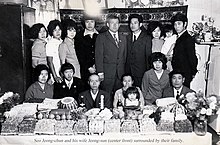
Back كوريو سخالين Arabic Sachalinští Korejci Czech Κορεάτες της Σαχαλίνης Greek Coreanos de Sajalín Spanish کرهایهای ساخالین Persian Coréens de Sakhaline French Korea Sakhalin ID Coreani di Sachalin Italian 在樺コリアン Japanese 사할린 한인 Korean
 | |
| Total population | |
|---|---|
| Over 55,000[1] | |
| Regions with significant populations | |
| 35,000 | |
| | 24,993[2] |
| 1,500 | |
| 1,000 | |
| Languages | |
| Russian, Korean | |
| Religion | |
| Christianity (Russian Orthodoxy[3] and Protestantism[4][5]) | |
| Related ethnic groups | |
| Korean diaspora, Koryo-saram | |
| Sakhalin Koreans | |||||
|---|---|---|---|---|---|
| Korean name | |||||
| Hangul | 사할린 한인 | ||||
| Hanja | 사할린 韓人 | ||||
| |||||
| Russian name | |||||
| Russian | Сахалинские корейцы or Корейцы Сахалина | ||||
| Romanization | Sakhalinskie Koreytsi or Koreytsi Sakhalina | ||||
Sakhalin Koreans (Korean: 사할린 한인; Russian: Сахалинские корейцы) are Russian citizens and residents of Korean descent living on Sakhalin Island, who can trace their roots to the immigrants from the Gyeongsang and Jeolla provinces of Korea during the late 1930s and early 1940s, the latter half of the Japanese ruling era.
At the time, the southern half of Sakhalin Island, then known as Karafuto Prefecture, was under the control of the Empire of Japan, whereas the northern half was part of the Soviet Union. The Japanese government both recruited and forced Korean labourers into service and shipped them to Karafuto to fill labour shortages resulting from World War II. The Red Army invaded Karafuto days before Japan's surrender; while all but a few Japanese there repatriated successfully, almost one-third of the Koreans could not secure permission to depart either to Japan or their home towns in South Korea. For the next forty years, they lived in exile. In 1985, the Japanese government offered transit rights and funding for the repatriation of the original group of Sakhalin Koreans; however, only 1,500 of them returned to South Korea in the next two decades. The vast majority of Koreans of all generations chose instead to stay on Sakhalin. Beginning in 2000, Hometown Village, a retirement community for first generation Sakhalins, has operated in Ansan.
Due to differing language and immigration history, Sakhalin Koreans may or may not identify themselves as Koryo-saram. The term "Koryo-saram" may be used to encompass all Koreans in the former USSR, but typically refers to ethnic Koreans from Hamgyŏng province whose ancestors emigrated to the Russian Far East in the 19th century, and then were later deported to Central Asia. The issue of self-identification is complicated by the fact that many Sakhalin Koreans feel that Koreans from Central Asia look down on them.[6]
- ^ Lee, Jeanyoung. "Ethnic Korean Migration in Northeast Asia" (PDF). Kyunghee University. Archived from the original (PDF) on 2 September 2006. Retrieved 27 November 2006.
{{cite journal}}: Cite journal requires|journal=(help) - ^ Национальный состав населения Сахалинской области[permanent dead link]
- ^ "Priest of the Russian Orthodox Church became Honorable Citizen of Seoul". www.orthodox.cn.
- ^ "22 Koreans to be repatriated from Sakhalin". The Vladivostok News. 30 March 2004. Archived from the original on 19 March 2005. Retrieved 26 November 2006.
- ^ Yi Jeong-jae. "사할린 한인의 종교와 신앙 및 의례: 유즈노사할린스크의 경우를 중심으로 (Religion, Faith, and Ceremonies of Sakhalin Koreans: Focusing on the case of Yuzhno-Sakhalinsk)" (in Korean). 실천민속학회. Retrieved 21 January 2007.
{{cite journal}}: Cite journal requires|journal=(help)[permanent dead link] - ^ Ban, Byung-yool (22 September 2004). "Koreans in Russia: Historical Perspective". The Korea Times. Archived from the original on 18 March 2005. Retrieved 20 November 2006.
© MMXXIII Rich X Search. We shall prevail. All rights reserved. Rich X Search